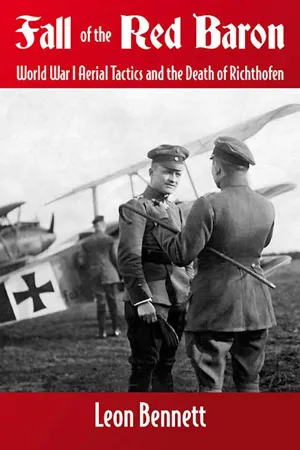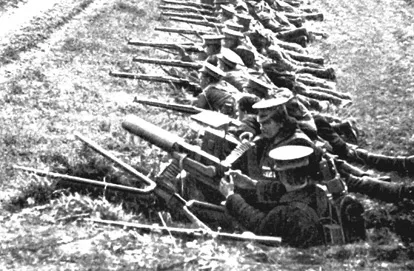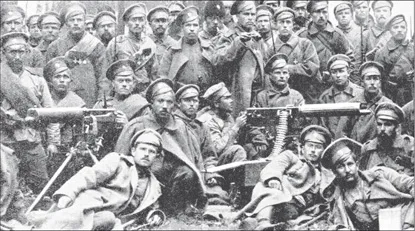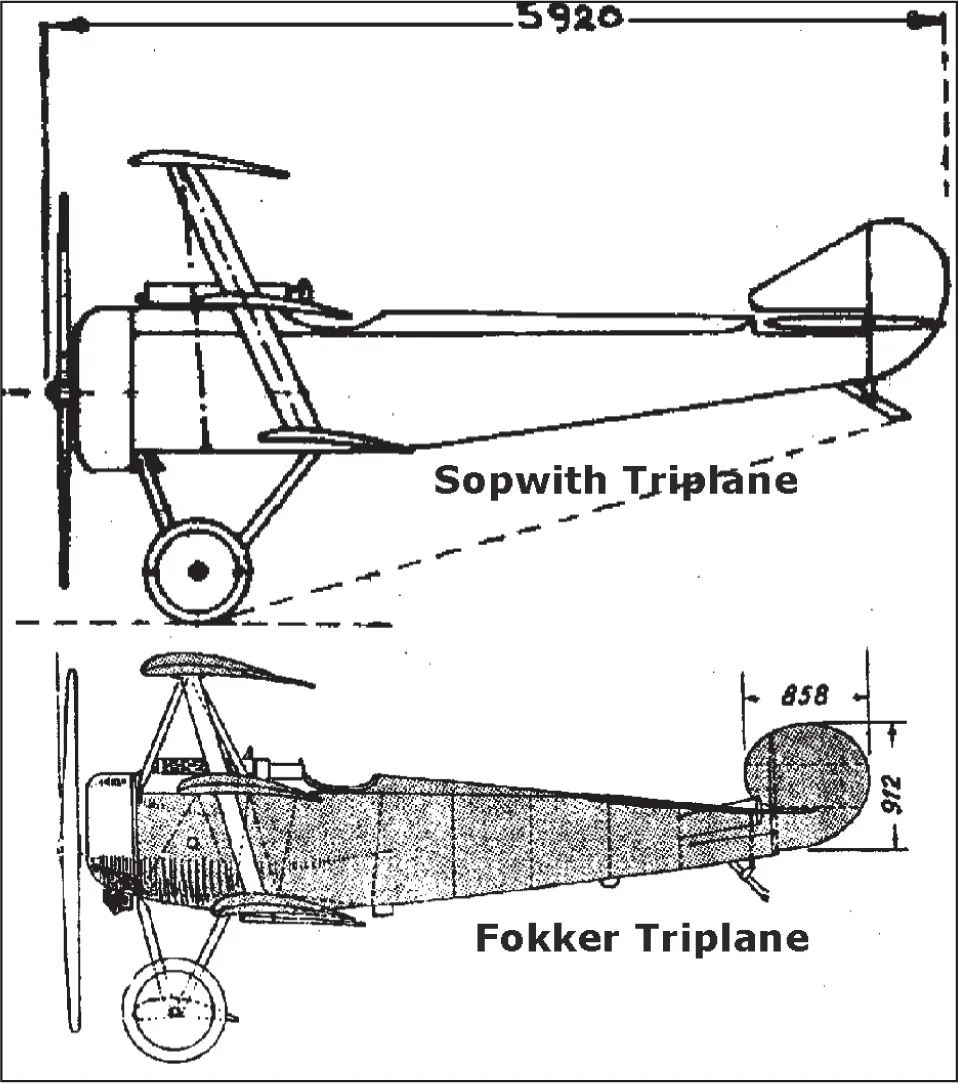![]()
1
Richthofen versus the Rifleman
We are certain that Richthofen’s life was ended by a single bullet on April 21, 1918. Though the basic facts are clear, the precise method remains unknown. In brief summary: while pursuing one aircraft, Richthofen was attacked by another. The fight moved to a low altitude, attracting bullets from small arms anti-aircraft units and infantry riflemen. At some point in this struggle, the fatal bullet was fired; a bullet that many claimed was their own. To date, detailed examination has not resolved the issue.
Sifting through the many possibilities – some reasonable, some strange indeed – and applying a careful skepticism to all, we are left with three likely, completely different possibilities: (1) he was brought down by a bullet fired by Canadian fighter pilot Captain Roy Brown; (2) he was killed by one of several teams of Australian anti-aircraft gunners armed with Vickers and Lewis machine guns; (3) he was hit and killed by a single shot fired by an unknown, ground-based rifleman.
Each of these possibilities has received support from knowledgeable veterans and historians. Though the destructive bullet itself was lost, Richthofen’s fatal wound was consistent with that resulting from a single standard .303 bullet used in British rifles and machine guns, or the equivalent German 7.92 mm. bullet.
Much has been said concerning the likelihood of methods (1) and (2) above. However, little has been offered concerning (3). This chapter’s purpose is to examine (3) in depth, using standard, accepted ballistic and engineering concepts.
For air defense, we instinctively turn to fighter planes, with anti-aircraft guns sensed as a less effective, secondary line of defense. In the 1914-1918 war, small arms fire, though recognized officially as a significant portion of anti-aircraft defense, was regarded as an inferior, limited weapon. Doubts were partly those based on range, for aircraft at altitudes greater than 2500 feet were beyond the reach of both machine gun and rifle fire.
Riflemen had additional limitations, even when firing against low flying aircraft. To work a hand operated, bolt-action gun meant aiming freshly before each round was fired. For serious marksmen, the result was a painfully slow firing rate, amounting to approximately 10 rounds per minute against a fixed, but distant target. Add on the difficulties inherent in targeting a fast moving aircraft – likely covering a distance of 7000 feet in that same minute – and grave doubts resulted concerning rifleman effectiveness.
These doubts were expressed by American ace Captain Eddie Rickenbacker, a man whose firsthand knowledge was indisputable, for some of it was gained by serving as the target of rifle fire. In his words:
How many riflemen can compute the exact point ahead of their gun muzzle where the bullet and the pilot’s head must meet? Not one! Occasional hits are made at random, but the percentage is ridiculously low … [it is] a hundred to one that no hits will be received.1
His case is clear and simple, and to a considerable extent correct. Certainly the prospects of an individual sharpshooter were not good. Yet, there were other, very different, and equally valid views. Consider those of British Captain Ira Jones, credited with 40 victories, many over the Western Front in 1918, at the time when Richthofen was brought down. Achieving such feats as the destruction of two Fokker D.VIIs in a single encounter,2 his expertise was beyond question. Concerning Richthofen’s death, Jones said: “It’s my belief that the fatal shot was from a rifle.”3
The conflict of views is obvious. Yet, each view contains much that smacks of the truth, in the way of possibility and probability. A closer examination is warranted.
The major difficulty with Rickenbacker’s argument was not the estimated rifleman’s odds – worse than ‘one in a hundred’ – for such a ratio may well have been realistic – but in a failure to pursue his own line of reasoning. Perhaps accuracy was not possible for any one rifleman. However, why limit consideration to only a single shooter? Imagine hundreds of riflemen firing at a low flying aircraft, with each man able to get off only two carefully aimed rounds in the course of a single overhead pass. The resulting spray of bullets made it possible that at least several would hit the aircraft, and that one bullet might hit a vital spot through pure chance. In other words, even if the possibility of any one rifleman’s bullet doing harm approached the negligible, as Rickenbacker indicated, the firing of many hundreds of bullets could well change the outcome.
At heart, this revised plan drops the traditional prospect of defense through the skills of experts in favor of defense produced by masses of men, each possessing little skill, and perhaps not even that. As everyone learns, given enough falling raindrops, we are likely to be hit, no matter how poor the aim of the rain gods.
How large were the number of shooters? Were hundreds really positioned to respond quickly enough to be effective? The mere existence of many hundreds of potential shooters, say a battalion of troops, didn’t mean that every man fired effectively. Some would fail to get the order, some were busy with other concerns and would sullenly ignore the order, some had inoperative rifles, or lacked ammunition, or froze in fear, or were away on leave, or were hopelessly inept. Given an unprepared battalion, perhaps the equivalent of one company’s rifles might be fired effectively. Were these enough?
For a real life example, consider a typical 1918 strafing run4 involving three American SPAD 13 aircraft against an estimated full company of German infantry soldiers, caught by surprise. In a single pass, one aircraft went unharmed and the other two were hit by a total of three bullets. None of the bullet strikes were fatal, though one machine required major repairs.
In another 1918 instance, American Captain Ray Bridgeman, crossing the lines in his SPAD 13 at about 500 feet, was brought down by a single bullet to his engine.5 Survivor Bridgeman believed the bullet came from the American side of the lines; the action of a misguided or embittered rifleman. Bridgeman wasn’t the only such victim. Rumors of false aircraft insignia employed to deceive the enemy were widespread,6 leading to ground-based shots from both sides, sometimes directed against the same machine.
Typical Machine Gun Sections
(top) British, Antwerp, 1914. (bottom) Russian, 1916. Heavy machine gun sections employed dozens of riflemen as helpers and defenders. They proved useful in the role of anti-aircraft marksmen. Source: (top) Baer C.H., Ed. Der Völkerkrieg (Stuttgart: Hoffmann, 1914) p.149; (bottom) Anon., The Times History of the War Volume 9 (London: The Times, 1916) p. 204
Triplane Similarity
Wartime German illustrations pointed to the striking similarity between British and German three-winged aircraft; a factor leading to mistaken bullets from a confused infantry. Source: (top) Flugsport, February 1918, p.104; (bottom) Flugsport, July 1918, p.n/a
Each side shared in this curious belief. For example, German General von Hoeppner7 noted that his troops were convinced that “foes were marking their planes with German insignias.” As a result, many Germans fired at anything that flew. The similarity of many designs, for example British and German triplanes, fostered the notion. See sketch.
Americans were also caught up in this paranoid world, consisting of flight under false colors. Innocent victims included anti-balloon ace pilots Frank Luke and Joe Wehner. One day commander Harold. E. Hartney found them8 “heatedly discussing the thousands of bullets fired at them, from our side of the lines as they made their way home … it happened many times.” The mere flying of clearly and correctly marked aircraft wasn’t enough. To certain minds, all aircraft were potentially those of the enemy. For such men, flight at a low altitude itself was sensed as proof of evil intent.
Luke and Wehner, concerned with shooting down observation balloons floating at a negligible altitude, required the lowest possible route for approach and return. As given by Hartney, “you have to come down within 100 feet of the ground … [and face] 10 to 20 machine guns and countless rifles.” 9 Unfortunately, this was exactly the path assigned by the paranoids to their enemies. Hence the “thousands of rounds” – much of it rifle fire – offered up by American troops to their own aces.
At times a low altitude did indeed indicate harmful intent. British pilot Lieutenant Sholto Douglas,10 intent on destroying a vital railroad bridge near Cambrai, France and fearful of missing with his too light bombs (20 lbs. each) flew over at a height of only 130 feet, receiving “much rifle fire” and “12 to 15 hits on my machine.” He survived, for his aircraft surface area (BE2c) was large and the truly sensitive area small, but the lesson was clear. The light damage his bombs inflicted upon the train line reinforced the moral – avoid low altitudes – because the penalties were large and the payoff small.
Ground strafing didn’t permit evasive tactics, for successful attack required flight approaching ground level. The inevitable results were frequent hits from return fire and a certain cool judgement about receiving aircraft hits. To American Elliot Springs,11 conducting strafing runs “at a couple of hundred feet,” the finding of a “few holes scattered about the plane, but nothing serious” reflected a typical day’s effort. Again, the aircraft’s critical area was small, and not easily struck.
Other strafers were not as lucky. American Lieutenant Bill Lambert, ground strafing in SE5’s with members of his 48th Squadron in April 1918, saw six of their machines crash as a result of return fire.12 Yet, oddly enough, “none of our pilots was badly hurt … ” Chance and luck could be very picky. Or perhaps it was a matter of that truly tiny sensitive area – that of a man plus engine plus fuel and oil tanks, along with a few vital control points.
To British intellectuals reaching for some sense of certainty in the uncertain world of return fire, the figure for truly sensitive target area was usually taken to be 20 square feet. A hit anywhere in this sector was interpreted as a total loss – be it of man or aircraft. This number arose from the pre-war work of British engineer M. O’Gorman.13 To determine the likelihood of return fire hits, he arranged for a locomotive to tow a large box kite containing a marked 20 square feet of sensitive area, serving as a target. Test shooters included regular Army riflemen numbering as many as 48, or a single Vickers machine gun. In the course of many runs 1587 rifle bullets were fired, and there were eight sensitive area hits, or roughly one in 200. Next, an expert machine gunner fired some hundreds of rounds and achieved the same level of accuracy: roughly one critical area hit per 200 rounds fired. In sum, the tests showed that whether fired by a rifle or machine gun, bullets had about one chance in 200 of hitting a sensitive spot on a remote, moving kite serving as a mock aircraft.
Modern criticism of the O’Gorman test would feature two serious departures from reality – those of kite speed and range. Certainly the kite speed of roughly 25 mph was too low to simulate an aircraft, and served to ease the shooting task. On the other hand, the range employed was too great, by some hundreds of yards, greatly increasing the difficulty of the shooters. These failures to duplicate actual wartime shooting conditions prevent serious consideration of the O’Gorman ‘one in 200’ result. We suspect that his result reflects only the proper order of magnitude, i.e. ‘one downed per hundreds fired.’ However, whatever the exact ratio might have been, it was apparent that given enough rounds fired, there would be successful hits in sensitive areas and ...




